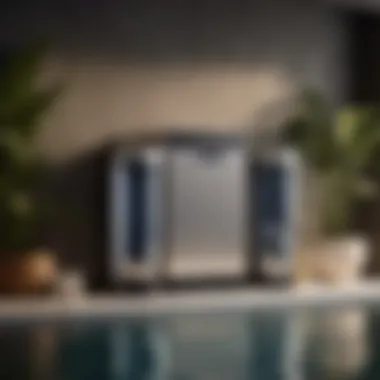An In-Depth Look at Whole House Water Filtration Systems: A Comprehensive Guide


Materials:
- Water filtration system kit (including filter cartridges, housing, valves, and fittings) - Ensure compatibility with whole house installation.
- Pipe cutter - For precise cutting of water supply pipes.
- Adjustable wrench - To tighten fittings securely.
- Teflon tape - For sealing threaded connections to prevent leaks.
- Measuring tape - To ensure accurate measurements for installation.
- Pipe fittings - Depending on the specific plumbing setup.
- Screwdriver - For securing components in place.
DIY Steps:
- Start by locating the main water supply line entering your house. This is where the filtration system will be installed.
- Turn off the water supply to prevent any leaks during the installation process.
- Measure and cut the pipes where the filtration system will be installed, following the manufacturer's guidelines.
- Assemble the water filtration system components according to the provided instructions, ensuring a secure fit.
- Connect the filtration system to the main water supply line using the appropriate fittings.
- Check all connections for leaks and tighten as needed.
Technical Aspects:
- Tools Required: Pipe cutter, adjustable wrench, screwdriver
- Timing: Installation time may vary but typically ranges from 1-3 hours.
- Critical Techniques: Ensure pipes are cut accurately for proper fittings without leaks.
DIY Project Process:
- Begin by preparing all necessary materials and tools as listed above.
- Follow the step-by-step instructions provided by the filtration system manufacturer for installation.
- Take note of any specific guidelines or recommendations to ensure optimal performance.
- Test the system once installation is complete to confirm proper functioning.
Troubleshooting Tips:
- If experiencing leaks, re-check connections and ensure they are tight and sealed with Teflon tape.
- In case of low water pressure, verify that the system is not clogged and filters are clean.
- If the system does not function correctly, consult the manufacturer's troubleshooting guide for solutions to common issues.
Introduction
Water filtration systems for whole-house use are becoming increasingly popular as more people are recognizing the importance of clean water. In this comprehensive guide, we will delve into the world of water filtration systems designed to ensure that every drop of water in your home is of the highest quality. From health implications to impacts on household appliances, understanding the role of whole-house filtration systems is essential for maintaining a healthy and sustainable living environment.
Significance of Clean Water
Clean water is not just a necessity but a fundamental requirement for a healthy lifestyle. The health implications of consuming contaminated water can be severe, leading to various health issues ranging from gastrointestinal problems to severe infections. Therefore, investing in a reliable water filtration system is crucial for safeguarding the health of you and your family. Additionally, the impacts on household appliances due to unfiltered water can be detrimental, causing scale buildup and reducing the efficiency and lifespan of appliances such as washing machines and dishwashers.
Health Implications
When it comes to health implications, the primary concern is the quality of the water we consume daily. Contaminants such as bacteria, viruses, heavy metals, and chemicals can pose significant health risks if not removed effectively. A whole-house water filtration system offers a comprehensive solution by removing impurities at the point of entry, ensuring that every tap in your home delivers clean and safe water for drinking, cooking, and bathing. The efficiency and reliability of these systems make them a popular choice for health-conscious individuals looking to maintain optimal water quality.
Impacts on Household Appliances
Unfiltered water can wreak havoc on household appliances, leading to scale buildup in pipes and appliances, reducing their efficiency over time. Minerals and sediments present in unfiltered water can cause clogging and damage, resulting in costly repairs and replacements. By installing a whole-house filtration system, you not only protect your appliances from damage but also extend their lifespan, ensuring they operate at peak performance.
Role of Whole-House Filtration Systems


Whole-house filtration systems play a vital role in ensuring that every drop of water in your home is pure and safe for consumption. These systems offer comprehensive water treatment solutions that address a wide range of contaminants, providing peace of mind to homeowners regarding their water quality. Additionally, whole-house filtration systems contribute to protecting the plumbing system by preventing the buildup of scale and sediments that can lead to plumbing issues.
Comprehensive Water Treatment
Achieving comprehensive water treatment is the primary objective of whole-house filtration systems. These systems incorporate multiple filtration stages, such as sediment filtration, carbon filtration, and reverse osmosis, to remove various impurities from the water supply. By combining different filtration technologies, whole-house systems ensure that water is thoroughly purified before it enters your home, meeting stringent quality standards and delivering pristine water for your daily needs.
Protecting Plumbing System
In addition to providing clean water for consumption, whole-house filtration systems contribute to protecting the plumbing system from damage caused by untreated water. Scale buildup in pipes can restrict water flow and increase the risk of leaks, leading to costly plumbing repairs. By removing sediments and minerals that contribute to scale formation, whole-house filtration systems help maintain the integrity of your plumbing infrastructure, ensuring efficient water distribution throughout your home.
Types of Water Filtration Systems
In the realm of water filtration systems for whole-house usage, understanding the varied types plays a crucial role in ensuring optimal water quality and safety within your living environment. Each type of filtration system offers distinct benefits and considerations that can significantly impact your decision-making process. By delving into the specifics of sediment filtration systems, carbon filtration systems, reverse osmosis systems, and UV water purification systems, you will gain a comprehensive understanding of the options available to safeguard your household water quality.
Sediment Filtration Systems
Mechanism of Action
The mechanism of action in sediment filtration systems involves the physical filtration of water to remove visible contaminants such as dirt, rust, and sand particles. This process relies on a series of filters with varying micron ratings to trap and eliminate sediments, ensuring cleaner and clearer water output. The key characteristic of sediment filtration is its ability to efficiently capture larger particles, effectively preventing them from entering your plumbing system or household appliances. While sediment filtration systems excel in removing visible impurities, it is important to note that they may not address microscopic contaminants present in the water.
Suitability for Different Water Types
Sediment filtration systems are highly suitable for areas with high sediment levels in their water sources, such as regions with well water or prone to sediment buildup. The key characteristic of this system lies in its capacity to handle varying sediment sizes, offering flexibility in treating different water compositions effectively. While sediment filtration systems are essential for removing visible debris, they may require more frequent filter replacements compared to other filtration methods. Understanding the unique features of sediment filtration systems and their pros and cons can aid in determining if this option aligns with your specific water quality needs.
Carbon Filtration Systems
Adsorption Process
Carbon filtration systems operate through an adsorption process where contaminants adhere to the surface of activated carbon filters, effectively removing impurities from the water. This innovative technique allows carbon filters to capture a wide range of pollutants, including chlorine, volatile organic compounds (VOCs), and chemicals, enhancing the taste and odor of your water. The key characteristic of the adsorption process is its ability to target specific contaminants, providing superior water purification results compared to traditional filtration methods. However, it is important to monitor the lifespan of carbon filters to maintain optimal filtration efficiency.
Taste and Odor Removal
One of the prominent features of carbon filtration systems is their effectiveness in taste and odor removal, significantly enhancing the palatability of your drinking water. By eliminating unpleasant tastes and odors caused by chlorine or organic compounds, carbon filters play a vital role in improving the overall drinking experience. While carbon filtration excels in enhancing water aesthetics and flavor, it may not necessarily address certain microbial or chemical contaminants present in the water. Evaluating the unique aspects of taste and odor removal in carbon filtration systems can guide you in evaluating its suitability for your household water filtration needs.
Reverse Osmosis Systems
High-Efficiency Filtration
Reverse osmosis systems employ a high-efficiency filtration process that utilizes a semi-permeable membrane to remove microscopic impurities from the water, producing exceptionally clean drinking water. This advanced technology is renowned for its ability to eliminate a broad spectrum of contaminants, including heavy metals, bacteria, and viruses, ensuring superior water quality outcomes. The key characteristic of high-efficiency filtration in reverse osmosis systems is its unparalleled purification capacity, delivering water that meets stringent quality standards. Despite its exceptional filtration performance, reverse osmosis systems may entail wastewater generation during the filtration process, emphasizing the importance of sustainable water disposal practices.


Wastewater Disposal
An inherent aspect of reverse osmosis systems is the disposal of wastewater created during the purification process, a key consideration for environmentally conscious users. While reverse osmosis excels in producing purified water, it generates a concentrated stream of wastewater containing the rejected contaminants and impurities. Efficient wastewater disposal methods are essential to minimize environmental impact and optimize the overall operation of reverse osmosis systems. Understanding the unique facets of wastewater disposal associated with reverse osmosis systems can assist in making informed decisions regarding their implementation and maintenance.
UV Water Purification Systems
Microbial Elimination
UV water purification systems utilize ultraviolet light to eradicate harmful microorganisms like bacteria, viruses, and protozoa present in the water supply, ensuring microbiologically safe drinking water. This method offers a chemical-free approach to disinfection, providing a sustainable and environmentally friendly solution for water treatment. The key characteristic of microbial elimination in UV systems is its ability to target a wide range of pathogens without altering water chemistry or taste. While UV purification is effective in microbial control, it may not remove certain chemical contaminants or particulates in the water, necessitating a comprehensive water treatment approach.
Chemical-Free Disinfection
A notable feature of UV water purification systems is their chemical-free disinfection process, which eliminates the need for additional chemicals to treat waterborne pathogens. This environmentally conscious approach minimizes the use of chlorine or other disinfectants, contributing to healthier water quality outcomes. The unique aspect of chemical-free disinfection in UV systems lies in its non-invasive method of microbial control, safeguarding water purity without introducing taste-altering substances. While UV purification excels in disinfection, understanding its limitations and advantages can guide you in making sound choices to enhance your water filtration strategy.
Installation and Maintenance
In the realm of water filtration systems for the entire home, installation and maintenance play pivotal roles in ensuring consistent performance and water quality. The process of installing a whole-house filtration system involves connecting the unit to the main water supply line, which requires careful planning and possibly professional assistance to guarantee optimal functionality. On the other hand, routine maintenance is crucial for sustaining the effectiveness of the system over time.
Professional Installation vs. DIY
Cost Considerations
When deliberating between professional installation and DIY approaches, cost considerations emerge as a fundamental aspect that influences decision-making. Opting for professional installation may incur higher upfront costs but offers expertise and assurance of correct setup. In contrast, DIY installation tends to be more budget-friendly but requires technical knowledge and may carry risks if not executed proficiently.
Technical Expertise
The factor of technical expertise is significantly relevant when exploring installation and maintenance procedures for whole-house filtration systems. Professional installation ensures that individuals with specialized knowledge handle the setup, optimizing the system's performance and longevity. On the other hand, those choosing the DIY route must possess adequate technical skills to avoid potential errors that could compromise the system's efficiency.
Routine Maintenance Practices
Filter Replacement
Ensuring timely filter replacement is crucial in maintaining the effectiveness of a whole-house filtration system. Regularly changing filters helps in removing contaminants efficiently, safeguarding water quality for household use. The key benefit of filter replacement lies in its capability to enhance the system's filtration abilities, resulting in consistently clean and safe water for consumption.
System Cleaning
System cleaning serves as another essential aspect of maintaining a whole-house filtration system. By periodically cleaning the unit, users can prevent the accumulation of sediments and impurities that might impair its functionality. The unique feature of system cleaning is its ability to prolong the lifespan of the filtration system by preventing clogs and performance issues, ultimately contributing to uninterrupted access to purified water for the entire household.
Cost Analysis


In this comprehensive guide to water filtration systems for the whole house, the section on Cost Analysis holds significant importance. Understanding the financial aspect of implementing a water filtration system is crucial for making informed decisions. By delving into the specific elements of cost analysis, readers can grasp the benefits and considerations associated with investing in such a system.
Initial Investment
Evaluation of Upfront Costs
When considering the initial investment required for a whole-house water filtration system, evaluating upfront costs plays a pivotal role. This aspect directly impacts the decision-making process, as it provides clarity on the financial commitment needed. The key characteristic of evaluating upfront costs lies in determining the total expense involved at the beginning of the installation process. This is a popular choice for this article because it sheds light on the immediate financial implications of setting up a water filtration system. By understanding the unique feature of upfront cost evaluation, readers can assess the advantages and potential drawbacks before making a financial commitment.
Included Features
Another crucial aspect of the initial investment in water filtration systems is the included features. These features contribute significantly to the overall value proposition of the system. Highlighting the key characteristics of included features helps readers understand why certain elements are considered beneficial or popular choices in this context. Describing the unique features of included features enables readers to evaluate the advantages and disadvantages specific to this article, allowing for a comprehensive assessment of what is offered.
Long-Term Expenses
Operational Costs
The long-term expenses associated with a whole-house water filtration system include operational costs, which are essential to consider. Operational costs encompass the regular expenses incurred in maintaining and running the filtration system over time. An exploration of the key characteristic of operational costs illuminates why this aspect is a popular choice within the context of this article. By describing the unique feature of operational costs, readers can weigh the advantages and disadvantages associated with the ongoing expenditure required to upkeep the system.
Replacement Components
Lastly, the consideration of long-term expenses involves replacement components. Understanding the significance of replacement components is crucial for ensuring the continuous effectiveness of the water filtration system. Highlighting the key characteristic of replacement components illustrates why they are considered beneficial or popular choices in the realm of water filtration. Delving into the unique feature of replacement components provides readers with insights into the advantages and potential disadvantages they may encounter throughout the lifespan of the system.
Conclusion
In this comprehensive guide to water filtration systems for the whole house, the conclusion plays a pivotal role in consolidating all the essential aspects discussed throughout the article. As readers navigate through the significance of clean water, the role of whole-house filtration systems, the types of filtration systems available, installation and maintenance procedures, and cost analysis, the conclusion serves as the ultimate synthesis of knowledge and considerations. It is the culmination of a detailed exploration that empowers individuals to make well-informed decisions regarding their water quality needs.
Key Considerations
Water Quality Prioritization
Water quality prioritization emerges as a critical aspect within the realm of whole-house water filtration systems. This element emphasizes the significance of ensuring not just the quantity but the quality of water throughout a household. With a focus on removing harmful contaminants, improving taste, and enhancing overall water purity, water quality prioritization stands as a fundamental principle guiding the selection and implementation of filtration systems. Choosing systems that prioritize water quality guarantees that residents have access to safe and clean water for various household uses.
Budgetary Constraints
Budgetary constraints play a crucial role in the decision-making process when investing in whole-house water filtration systems. Understanding the financial implications of such systems is essential to aligning the investment with available resources. By considering upfront costs, operational expenses, and long-term maintenance requirements, individuals can strike a balance between quality and affordability. While budgetary constraints may necessitate trade-offs in features or technologies, careful planning and assessment can ensure that the chosen filtration system offers optimal value within the specified budget.
Final Decision
Personal Preferences
Personal preferences contribute significantly to the final decision-making process when selecting a whole-house water filtration system. These preferences may stem from individual priorities, lifestyle choices, or specific water quality concerns. Whether aiming for enhanced taste, reduced chemicals, or environmentally friendly solutions, aligning personal preferences with the features and functions of the filtration system is crucial in achieving satisfaction and peace of mind regarding water quality at home.
Professional Consultation
Professional consultation serves as a valuable resource for individuals seeking expert guidance in choosing and installing whole-house water filtration systems. By leveraging the knowledge and experience of professionals in the field, homeowners can gain insights into market trends, technological advancements, and system compatibility with their household needs. The expertise provided by professionals not only ensures the proper selection and installation of filtration systems but also offers ongoing support and maintenance strategies tailored to maximize system efficiency and longevity.







